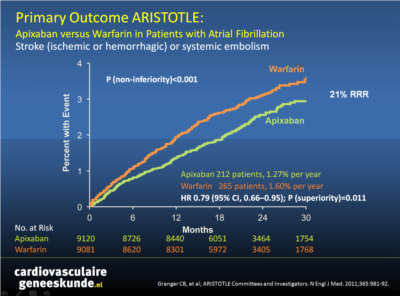De ARISTOTLE-studie: apixaban vergeleken met warfarine bij AF
Literatuur - Granger CB et al, N Engl J Med. 2011;365:981-92Apixaban versus Warfarin in Patients with Atrial Fibrillation
Granger CB, Alexander JH, et al; ARISTOTLE Committees and Investigators.
N Engl J Med. 2011;365:981-92.
Samenvatting
Warfarine is effectief in het voorkomen van stroke bij patiënten met atriumfibrilleren. Het middel heeft echter beperkingen, waaronder interacties met geneesmiddelen en voedingsmiddelen, een smalle therapeutische breedte, de noodzaak om de antistolling te bewaken, en bloedingen. Apixaban is een nieuwe orale factor Xa remmer waarvan is aangetoond dat het stroke en systemische embolie met 55% kan verminderen vergeleken met aspirine in patiënten met AF die niet geschikt zijn voor warfarine.In de ARISTOTLE-studie werd apixaban vergeleken met warfarine bij patiënten met AF. Apixaban was superieur aan warfarine bij het voorkomen van stroke of systemische embolie (21% reductie, p=0.01). Het veroorzaakte minder bloedingen (reductie grote bloedingen 31%, p<0.001) en gaf een lagere mortaliteit (11% reductie, p=0.047).
Abstract
Background:
Vitamin K antagonists are highly effective in preventing stroke in patients with atrial fibrillation but have several limitations. Apixaban is a novel oral direct factor Xa inhibitor that has been shown to reduce the risk of stroke in a similar population in comparison with aspirin.
Methods:
In this randomized, double-blind trial, we compared apixaban (at a dose of 5 mg twice daily) with warfarin (target international normalized ratio, 2.0 to 3.0) in 18,201 patients with atrial fibrillation and at least one additional risk factor for stroke. The primary outcome was ischemic or hemorrhagic stroke or systemic embolism. The trial was designed to test for noninferiority, with key secondary objectives of testing for superiority with respect to the primary outcome and to the rates of major bleeding and death from any cause.
Results:
The median duration of follow-up was 1.8 years. The rate of the primary outcome was 1.27% per year in the apixaban group, as compared with 1.60% per year in the warfarin group (hazard ratio with apixaban, 0.79; 95% confidence interval [CI], 0.66 to 0.95; P<0.001 for noninferiority; P=0.01 for superiority). The rate of major bleeding was 2.13% per year in the apixaban group, as compared with 3.09% per year in the warfarin group (hazard ratio, 0.69; 95% CI, 0.60 to 0.80; P<0.001), and the rates of death from any cause were 3.52% and 3.94%, respectively (hazard ratio, 0.89; 95% CI, 0.80 to 0.99; P=0.047). The rate of hemorrhagic stroke was 0.24% per year in the apixaban group, as compared with 0.47% per year in the warfarin group (hazard ratio, 0.51; 95% CI, 0.35 to 0.75; P<0.001), and the rate of ischemic or uncertain type of stroke was 0.97% per year in the apixaban group and 1.05% per year in the warfarin group (hazard ratio, 0.92; 95% CI, 0.74 to 1.13; P=0.42).
Conclusions:
In patients with atrial fibrillation, apixaban was superior to warfarin in preventing stroke or systemic embolism, caused less bleeding, and resulted in lower mortality.


Deel deze pagina met collega's en vrienden: